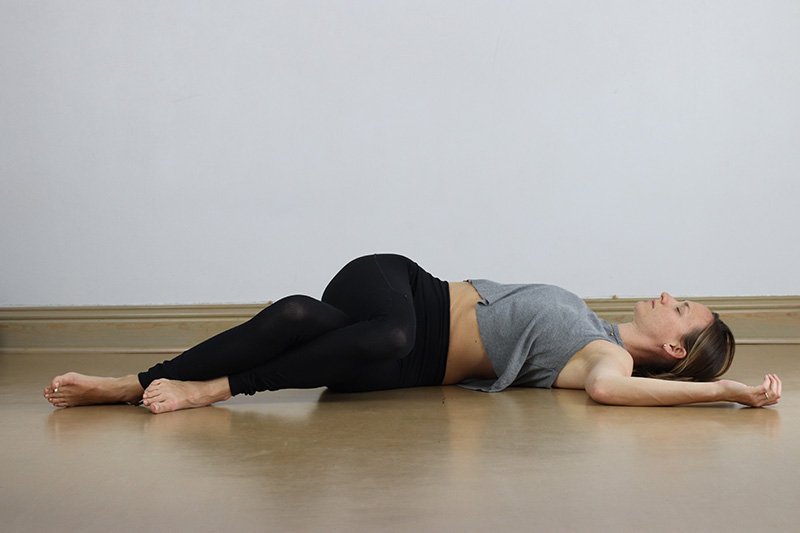The Power of Sitting With Discomfort
Do you ever get yin and restorative yoga confused? I’ve been having a lot of conversations with practitioners recently who are trying yin for the first time about the difference. Yin is finding an edge and sitting there, maybe with a little discomfort. There is no pain, no pushing but rather sitting at that edge. Some have described the sensation like a surfer riding a wave, feeling the discomfort and when to ease into the pose and when to draw back.
Yin Yoga has three tattvas, or principles, the first of which is to come into the pose to an appropriate depth. This is where you start to feel resistance in the body, maybe the start of a little discomfort before the body starts to open up into the practice.
But why do we want this little bit of resistance?
Yin yoga presents a great opportunity to get comfortable with being uncomfortable, to invite discomfort in.
As humans we avoid discomfort, whether it’s a hard conversation with a friend / family member or pushing that little bit further in a workout. Even having our phones always with us, we might be avoiding uncomfortable silences or the discomfort of being bored. And it’s logical, our comfort zones keep us safe. But safety can sometimes make us feel a little stuck.
And may suppress discomfort in the body. Have you ever felt a weight lifted after a yoga class, or felt yourself being a little more emotional post practice? Maybe you have released some discomfort - whether that be physical, mental or emotional. To cry tears of joy or sadness is fairly common in a yin practice as these are released.
“Generally speaking, we regard discomfort in any form as bad news. But for practitioners… feelings like disappointment, embarrassment, irritation, resentment, anger, jealousy, and fear, instead of being bad news, are actually very clear moments that teach us where it is that we’re holding back. They teach us to perk up and lean in when we feel we’d rather collapse and back away. They’re like messengers that show us, with terrifying clarity, exactly where we’re stuck. This very moment is the perfect teacher, and, lucky for us, it’s with us wherever we are.” - Pema Chödrö
What if it’s too much?
We all know our own personal boundaries and our edge. Yin is not pushing but rather yielding. If you find yourself too uncomfortable or unable to confront sensations, emotions, thoughts and / or feelings then part of your practice is to slowly back off.
Discomfort can be daunting, and feel like a huge leap. It is your practice.
How to find the physical discomfort easier:
Make sure you practice in an environment that engages your senses: Often yin is practiced with incense / candles etc. that stimulate your sense of smell, the lights are dimmed, with some music playing or instruments being played. This helps stimulate without being overwhelming. This allows you to remain present while staying still, and can help relax the nervous system.
Focus on the fact that this pose is temporary: If there’s a particular pose you find uncomfortable just know that 2 minutes is a blink of the eye, and soon you’ll be moving into an asana that is your idea of heaven (supported fish pose anyone?). You don’t want to be clock watching but breathing through a pose and knowing it’s one of a few can help mentally deal with any sensations that arise.
Know that some days are harder than others: Ever been to a class and left floating on air, it just felt so good. Just what you needed. Those days are pure magic. And sometimes the opposite can happen - monkey mind is kicking in, and everything feels a little tight. That’s normal - and often that’s where the growth happens. Sit with it and know a practice can feel different throughout, or even that you might feel the difference after.
Ensure you’re not thinking of pain as discomfort: any form of distress both physically and mentally should be avoided. It’s okay to find your edge and rest there, but if you find it too much then back off. Sometimes we hold trauma or negative emotions in the body, if you feel these rising to the surface and they’re too much then back off the pose. Find a nicer variation, or an alternative posture.
Remember, you are your greatest teacher. You know what is discomfort and what is pain - your yoga teacher can’t tell you this.
And you never know, you might find yourself sitting in silence more comfortably, or having that uncomfortable conversation at work you’ve been needing to for a while. Take some time to reflect every now and again, sometimes we don’t notice our progress until we look back.
Some poses that activate the stomach and spleen meridian - helping to release resistance:
Wild legged child’s pose
Butterfly pose
Reclined twist
Dragonfly pose
Child's Pose
Butterfly
Reclined Twist Variation
Dragonfly




